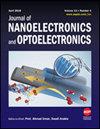氧化锌/rGO 纳米复合材料的表征及其在光催化降解中的应用
IF 0.6
4区 工程技术
Q4 ENGINEERING, ELECTRICAL & ELECTRONIC
引用次数: 0
摘要
采用水热法成功合成了带有还原氧化石墨烯(rGO)的氧化锌(ZnO)纳米棒(NRs),并进行了额外的喷涂。本文重点研究了 rGO 涂层对 ZnO 和 rGO 之间电荷转移和相互作用的影响,这种影响显著提高了基于 ZnO 的 NRs 的电学和光学性能。本文使用 FESEM、PL 光谱和 XPS 对合成的 ZnO/rGO 纳米复合材料进行了表征。FESEM 分析结果表明,合成的 NRs 表面形貌为六角形棒状结构,棒顶端覆盖有 rGO 层。陶氏图谱分析表明,rGO 层将 ZnO NRs 的带隙从 3.25 eV 降低到 3.17 eV,光吸收增加。利用 XPS 研究了 ZnO NRs/rGO 纳米复合材料中的化学成分、电子状态和元素之间的相互作用。由于 rGO 沉积层的存在,氧物种的峰值位置向更高的结合能移动。这种半导体与石墨烯材料的杂化减小了带隙,降低了 PL 发射。最后,研究了 ZnO NRs/rGO 通过氧化降解亚甲基蓝的光催化活性。结果表明,ZnO NRs/rGO 的光催化反应速率常数大于原始 ZnO NRs。本文章由计算机程序翻译,如有差异,请以英文原文为准。
Characterization of ZnO/rGO Nanocomposite and Its Application for Photocatalytic Degradation
Zinc oxide (ZnO) nanorods (NRs) with reduced graphene oxide (rGO) were successfully synthesized using a hydrothermal method with an additional spray coating. This paper focuses on the effect of rGO coating on charge transfer and interaction between ZnO and rGO that remarkably contributes to the enhancement of the electrical and optical properties of ZnO-based NRs. The synthesized ZnO/rGO nanocomposite was characterized using FESEM, PL spectroscopy and XPS. FESEM analysis results showed that the surface morphology of the synthesized NRs had a hexagonal rod structure covered with rGO layers on the tip of the rod. The Tauc Plot analysis revealed that the rGO layers reduced the bandgap of ZnO NRs from 3.25 eV to 3.17 eV, where the light absorption increased. The chemical composition, electronic state, and interactions between the elements in the ZnO NRs/rGO nanocomposites were investigated using XPS. The presence of oxygen species due to the rGO deposition layers is indicated by the shift of the peak position toward a greater binding energy. The hybridization of this semiconductor and graphene material reduced the bandgap and lowered the PL emission. Finally, the photocatalytic activity of ZnO NRs/rGO has been studied for methylene blue degradation via oxidation. The results showed that the photocatalytic reaction rate constant of ZnO NRs/rGO > pristine ZnO NRs.
求助全文
通过发布文献求助,成功后即可免费获取论文全文。
去求助
来源期刊

Journal of Nanoelectronics and Optoelectronics
工程技术-工程:电子与电气
自引率
16.70%
发文量
48
审稿时长
12.5 months
 求助内容:
求助内容: 应助结果提醒方式:
应助结果提醒方式:


